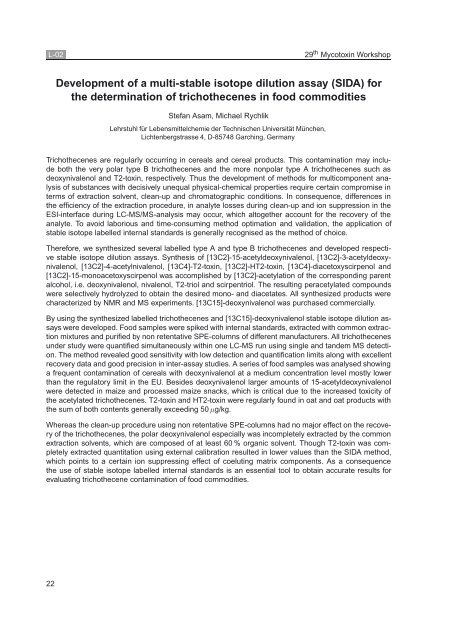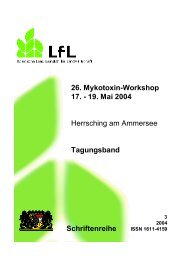Table of Lectures - Society for Mycotoxin Research
Table of Lectures - Society for Mycotoxin Research
Table of Lectures - Society for Mycotoxin Research
Create successful ePaper yourself
Turn your PDF publications into a flip-book with our unique Google optimized e-Paper software.
L-02 29 th <strong>Mycotoxin</strong> Workshop<br />
Development <strong>of</strong> a multi-stable isotope dilution assay (SIDA) <strong>for</strong><br />
the determination <strong>of</strong> trichothecenes in food commodities<br />
Stefan Asam, Michael Rychlik<br />
Lehrstuhl für Lebensmittelchemie der Technischen Universität München,<br />
Lichtenbergstrasse 4, D-85748 Garching, Germany<br />
Trichothecenes are regularly occurring in cereals and cereal products. This contamination may include<br />
both the very polar type B trichothecenes and the more nonpolar type A trichothecenes such as<br />
deoxynivalenol and T2-toxin, respectively. Thus the development <strong>of</strong> methods <strong>for</strong> multicomponent analysis<br />
<strong>of</strong> substances with decisively unequal physical-chemical properties require certain compromise in<br />
terms <strong>of</strong> extraction solvent, clean-up and chromatographic conditions. In consequence, differences in<br />
the efficiency <strong>of</strong> the extraction procedure, in analyte losses during clean-up and ion suppression in the<br />
ESI-interface during LC-MS/MS-analysis may occur, which altogether account <strong>for</strong> the recovery <strong>of</strong> the<br />
analyte. To avoid laborious and time-consuming method optimation and validation, the application <strong>of</strong><br />
stable isotope labelled internal standards is generally recognised as the method <strong>of</strong> choice.<br />
There<strong>for</strong>e, we synthesized several labelled type A and type B trichothecenes and developed respective<br />
stable isotope dilution assays. Synthesis <strong>of</strong> [13C2]-15-acetyldeoxynivalenol, [13C2]-3-acetyldeoxynivalenol,<br />
[13C2]-4-acetylnivalenol, [13C4]-T2-toxin, [13C2]-HT2-toxin, [13C4]-diacetoxyscirpenol and<br />
[13C2]-15-monoacetoxyscirpenol was accomplished by [13C2]-acetylation <strong>of</strong> the corresponding parent<br />
alcohol, i.e. deoxynivalenol, nivalenol, T2-triol and scirpentriol. The resulting peracetylated compounds<br />
were selectively hydrolyzed to obtain the desired mono- and diacetates. All synthesized products were<br />
characterized by NMR and MS experiments. [13C15]-deoxynivalenol was purchased commercially.<br />
By using the synthesized labelled trichothecenes and [13C15]-deoxynivalenol stable isotope dilution assays<br />
were developed. Food samples were spiked with internal standards, extracted with common extraction<br />
mixtures and purified by non retentative SPE-columns <strong>of</strong> different manufacturers. All trichothecenes<br />
under study were quantified simultaneously within one LC-MS run using single and tandem MS detection.<br />
The method revealed good sensitivity with low detection and quantification limits along with excellent<br />
recovery data and good precision in inter-assay studies. A series <strong>of</strong> food samples was analysed showing<br />
a frequent contamination <strong>of</strong> cereals with deoxynivalenol at a medium concentration level mostly lower<br />
than the regulatory limit in the EU. Besides deoxynivalenol larger amounts <strong>of</strong> 15-acetyldeoxynivalenol<br />
were detected in maize and processed maize snacks, which is critical due to the increased toxicity <strong>of</strong><br />
the acetylated trichothecenes. T2-toxin and HT2-toxin were regularly found in oat and oat products with<br />
the sum <strong>of</strong> both contents generally exceeding 50 µg/kg.<br />
Whereas the clean-up procedure using non retentative SPE-columns had no major effect on the recovery<br />
<strong>of</strong> the trichothecenes, the polar deoxynivalenol especially was incompletely extracted by the common<br />
extraction solvents, which are composed <strong>of</strong> at least 60 % organic solvent. Though T2-toxin was completely<br />
extracted quantitation using external calibration resulted in lower values than the SIDA method,<br />
which points to a certain ion suppressing effect <strong>of</strong> coeluting matrix components. As a consequence<br />
the use <strong>of</strong> stable isotope labelled internal standards is an essential tool to obtain accurate results <strong>for</strong><br />
evaluating trichothecene contamination <strong>of</strong> food commodities.<br />
22



